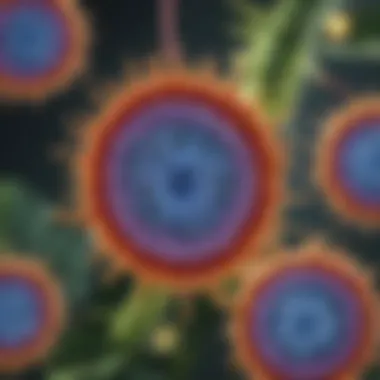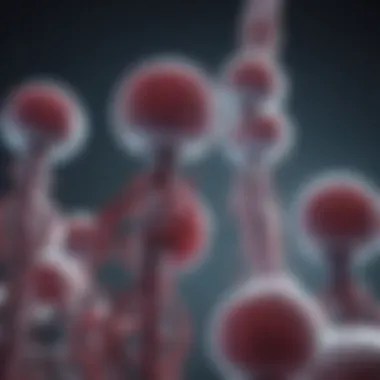Trans Genes: Understanding Their Role in Science


Intro
In the age of rapid technological advancement, the field of genetics is undergoing a significant transformation, and trans genes occupy a pivotal role in this evolution. Transgenes, which are genes that have been transferred from one organism to another, primarily through genetic engineering techniques, are making waves in various sectors, from agriculture to medicine. Understanding the implications of transgenes requires a discerning eye towards the ongoing research, the ethical debates which envelop them, and their practical applications. This exploration not only provides a glimpse into the science underlying these genetic modifications but also invites the readers to ponder the societal repercussions they may entail.
Research Overview
Summary of Key Findings
The exploration of trans genes reveals some groundbreaking discoveries that have emerged in recent years. Researchers have identified several methodologies for the successful integration of transgenes into host organisms. These techniques include methods like agrobacterium-mediated transformation and CRISPR-Cas9 gene editing, providing more precision and efficiency in the genetic modification process.
Furthermore, studies show that transgenes have significantly improved crop resistance to pests and diseases. For instance, Bt cotton, which incorporates a toxin from the bacterium Bacillus thuringiensis, has not only boosted crop yields but also reduced dependency on chemical pesticides.
Additionally, in the realm of medicine, transgenes have facilitated the development of therapies addressing genetic disorders. One prominent example is gene therapy that targets inherited diseases, showcasing the potential of trans genes in revolutionizing healthcare.
Relevance to Current Scientific Discussions
The relevance of transgenes in scientific discourse cannot be overstated. As genetic engineering continues to advance, discussions around transgenes weave through various threads—from climate change and food security to genetic equity and bioethics. As agriculture strives to meet the needs of a growing global population, the enhancement of crops through transgenic techniques prompts questions about sustainability and environmental impact.
Moreover, the implications extend to human health, where the ethical dimensions of altering genetic makeup in therapies present urgent debates among healthcare professionals and ethicists alike. The academic community finds itself engaged in lively discussions about not just the feasibility of transgenic solutions, but also their moral acceptability in society.
Methodology
Research Design and Approach
This examination of transgenes employs a multidisciplinary approach, integrating perspectives from molecular biology, ethics, and agricultural science. Through case studies and peer-reviewed literature, the research draws upon quantitative data and qualitative insights, creating a comprehensive understanding of the topic.
Data Collection and Analysis Techniques
Data for this study has been sourced from various academic journals, government publications, and industry reports. Techniques range from meta-analysis of previously published studies to field experiments assessing the efficacy of transgenic crops in real-world scenarios.
In summation, as we delve deeper into the intricate world of trans genes, this article aims to provide both a scientific blueprint and a moral compass for navigating the complexities of genetic engineering. The journey of understanding trans genes is as much about uncovering scientific truths as it is about addressing the broader implications for humanity.
Preamble to Trans Genes
In the rapidly evolving landscape of biological sciences, trans genes play a pivotal role in reshaping our understanding of genetics and biotechnology. Trans genes, or genes that have been transferred from one organism to another, can serve as tools for enhancing organism traits, combating diseases, and even addressing food security challenges. In this section, we will touch on fundamental concepts that create a foundation for further exploration of trans genes.
The importance of understanding trans genes cannot be overstated. These genetic modifications could lead to substantial advances in various fields, from agriculture to medicine. By tweaking specific genes, scientists can engineer plants that grow under harsh environmental conditions or develop therapies targeting gene-related disorders in humans. But with great power comes great responsibility; it's essential to also reflect on ethical considerations and societal implications.
Definition of Trans Genes
A trans gene refers to a gene that has been deliberately inserted into an organism's genome using genetic engineering techniques. This transfer can happen across different species, making it possible for traits from one organism to be expressed in another. For instance, genes from a bacterium may be inserted into a plant to confer resistance to certain pests or diseases.
To put it in simpler terms, think of a trans gene as a new recipe added to an existing cookbook, enabling the organism to produce traits it wouldn't naturally possess. The alteration often aims for specific benefits such as increased yield in crops or improved resistance to diseases.
Historical Context
The road to the present understanding of trans genes has been long and fraught with challenge and triumph. The journey began in the 1970s with the introduction of recombinant DNA technology, which allowed scientists to move genes between organisms. During this time, an important backdrop for trans genes began to form. The groundbreaking work of biochemists like Paul Berg and Herbert Boyer opened the floodgates for genetic manipulation. The first genetically modified organism, a bacterium engineered to produce insulin, set the stage for further advances.
Fast forward to the 1990s, the flowering of Genetically Modified Organisms (GMOs) entered people's daily lives with the introduction of transgenic crops. For instance, the Flavr Savr tomato was among the very first genetically engineered food products commercially available.
Still, as history has shown, scientific advancements are often shadowed by public debate. The introduction of GMOs sparked discussions about safety, ethics, and environmental impact, shaping regulatory landscapes worldwide. Today, trans genes represent a blended historical narrative of innovation tempered with caution, igniting discourse on the ongoing contributions of these transformational tools.
Mechanisms Behind Trans Gene Functionality
Understanding the mechanisms behind trans gene functionality is crucial. This area provides insights into how transgenes are integrated, expressed, and regulated within host organisms. By comprehending these mechanisms, researchers and practitioners can improve the efficiency and effectiveness of genetic engineering applications across various fields, from agriculture to medicine.
Transgene Integration Processes
Transgene integration, the first step in any successful genetic modification, involves the introduction of foreign genes into an organism's genome. This process can happen through various methods, each with its benefits and challenges. Here are some significant techniques involved:
- Agrobacterium-Mediated Transformation: This is a common method for plants, where Agrobacterium tumefaciens acts as a vector to deliver the transgene. The bacteria transfer genetic material into the plant cells, leading to stable integration of the transgene into the plant genome.
- Particle Bombardment (Biolistics): This method involves shooting tiny DNA-coated gold or tungsten particles into plant tissues. While effective, it's less predictable than Agrobacterium.
- Electroporation: In this technique, an electrical field increases the permeability of the cell membrane, allowing the foreign DNA to enter the cell. While largely used in microbial and animal cells, it is still less common in plants.
- CRISPR/Cas9: An advanced technique, CRISPR allows for precise editing of genes. This can integrate new genetic material at targeted locations within the genome, offering a high degree of control over gene expression.


However, not all methods offer equal success rates regarding stable integration. The choice of method often depends on the targeted organism, the nature of the transgene, and the desired outcome of the modification. Many scientists still explore new ways to refine these techniques for better precision and efficiency.
Expression and Regulation of Trans Genes
Once incorporated, regulating the expression of trans genes is critical. Expression levels must be carefully modulated to ensure that the transgenic traits, such as pest resistance or enhanced growth, are beneficial without unintended consequences. Some key factors influencing expression and regulation include:
- Promoter Selection: The choice of promoter determines when and where a transgene is expressed. For instance, constitutive promoters provide constant expression across tissues, while tissue-specific promoters limit expression to particular tissues.
- Epigenetic Modifications: Methylation and histone modifications can influence the accessibility of the transgene to transcription machinery, thereby regulating its expression. Understanding these mechanisms allows researchers to manipulate gene expression subtly but effectively.
- Environmental Factors: External conditions, such as light, temperature, and stress, can also impact how effectively trans genes are expressed. For example, stress-resistant genes may only activate under specific stress conditions, thus conserving energy and resources in a healthy plant.
"The regulation of trans gene expression is as critical as the integration process itself. Without precise control, the intended benefits of genetic modifications could be lost."
Applications of Trans Genes in Agriculture
The integration of trans genes in agriculture marks a significant juncture in modern farming practices. By allowing scientists to enhance the genetic makeup of crops, we step into a realm where agricultural yields can be improved, pest resistance can be bolstered, and sustainability could be feasibly achieved. This section aims to unravel the essentials surrounding these applications, their benefits, and considerations.
Genetically Modified Crops
Genetically modified crops, often referred to as GMOs, embody a prominent application of trans genes. From corn to soybeans, these plants have undergone genetic alterations that afford a variety of advantages over their non-modified counterparts. For instance, Bt corn is engineered to express a protein from the bacterium Bacillus thuringiensis, which acts as a pesticide against certain insects. Farmers who adopt such crops often reap the rewards of higher yields and reduced dependence on chemical pesticides.
Here are some notable benefits of genetically modified crops:
- Increased Yield: Crops can be engineered for higher productivity, which is crucial as global food demand grows.
- Pest Resistance: By incorporating natural pesticide traits, farmers can protect their crops with less chemical input.
- Herbicide Tolerance: Certain crops are modified to tolerate herbicides, allowing for easier weed control without damaging the crop itself.
Enhancement of Crop Resistance
As climate change and disease pressures mount on traditional crops, enhancing crop resistance becomes ever more critical. Altering the genetic code of plants to withstand drought, salinity, or diseases could save farmers from the brink of disaster. Take the development of Golden Rice, which has been engineered to combat vitamin A deficiency - a crucial health issue in many developing countries. With specific genes inserted, this rice has the potential to provide essential nutrients to vulnerable populations.
Additionally, crops like papaya have been modified to withstand the ringspot virus. The exemplary case of the Hawaiian papaya industry highlights how genetic modification can serve as a lifeline against agricultural crises.
Sustainability Considerations
While the advantages of trans genes in agriculture are compelling, several sustainability considerations need to be carefully weighed. The debate around GMOs often revolves around their potential effects on biodiversity and ecosystem health. Some key points include:
- Environmental Impact: The long-term effects of widespread GMO cultivation on local ecosystems continue to raise questions, particularly regarding the potential for gene transfer to wild relatives.
- Soil Health: Ensuring that modifications do not adversely affect soil biodiversity is crucial, as healthy soil sustains diverse forms of life necessary for balanced ecosystems.
- Market Dynamics: As companies hold patents for genetically modified seeds, the dependency of farmers on a few major players for seeds can disrupt local economies and create inequities.
"Sustainable agriculture must balance productivity with environmental health."
Navigating the landscape of trans genes in agriculture requires a multifaceted approach—balancing innovation with responsible stewardship. As the technologies evolve, ongoing dialogue among stakeholders, researchers, and consumers remains essential for fostering an informed understanding of the implications of trans genes in our agricultural systems.
Trans Genes in Medicine: Innovations and Challenges
Trans genes have emerged as a cornerstone in the rapidly evolving field of modern medicine. Their implications stretch far beyond mere theoretical applications; they represent a genuine frontier in treatment possibilities. By harnessing the power of genetic engineering, trans genes allow us to tackle complex diseases that, until recently, seemed insurmountable. From gene therapy to advanced vaccine development, the exploration of trans genes is reshaping our understanding of health and disease. However, this progress does not come without its share of challenges and ethical dilemmas that require careful navigation.
Gene Therapy Applications
Gene therapy has certainly been a game-changer in medicine, primarily due to its ability to correct genetic disorders at their source. By introducing a healthy copy of a gene or even replacing faulty genes, researchers have been able to produce remarkable results in treating conditions like cystic fibrosis and sickle cell disease. For individuals struggling with genetic disorders, this offers a hope that was once the stuff of dreams.
Nevertheless, there are numerous complexities surrounding gene therapy. One pressing concern is, how do we deliver trans genes efficiently and safely? Techniques such as viral vectors have shown promise, but they can pose risks, including immune reactions and unintended consequences.
- Benefits of Gene Therapy:
- Direct intervention at the genetic level
- Potential for long-lasting effects
- Targeted treatments that can result in minimal side effects
Vaccines and Trans Genes
Vaccines tap into the body’s immune response, and incorporating trans genes has supercharged this approach. The recent development of mRNA vaccines, like those for COVID-19, showcase how trans genes can instruct our cells to produce specific proteins, triggering an immune response. This not only demonstrates efficacy but also highlights how quickly such vaccines can be developed when there's enough scientific infrastructure.
However, while these vaccines show incredible potential, public skepticism remains a barrier. Misunderstandings about how transgenes work can fuel fears. Transparency is key—those developing these technologies must prioritize clear communication to foster trust in new medical solutions.
"The healing of the future requires trusting the science while understanding the fears associated with it."
Ethical Dilemmas in Medical Biotechnology
With great innovation often comes great responsibility. The applications of trans genes in medicine bring about ethical questions that society must grapple with. One significant concern is the prospect of 'designer genes'—the ability to modify genetic traits, opening a Pandora's box of moral dilemmas.


Key ethical issues include:
- Equity in Access: Will only wealthy individuals have access to these advanced therapies?
- Long-term Effects: What are the implications of altering human genetics for future generations?
- Informed Consent: Are patients being fully informed of the risks and benefits associated with treatments involving trans genes?
As we forge ahead into this brave new world of transgene applications in medicine, it is crucial to keep an open dialogue among scientists, ethicists, and the public. Only by understanding the innovations and the challenges they bring can we create a medical landscape that respects both science and the moral considerations of society.
Case Studies of Trans Gene Implementation
The study of trans genes is not for the faint of heart. This exploration provides a vivid tapestry of real-world experiences, showcasing the triumphs and pitfalls of transgene technology. Each case study presents invaluable lessons, highlighting successful applications and shedding light on controversies and failures. Understanding these narratives is crucial for fostering an informed dialogue about the future of genetic engineering and its societal implications.
Successful Applications in the Field
Transgenes have found their footing in numerous applications that showcase their potential benefit. For instance, the introduction of the Bt corn, genetically engineered to express a bacterial toxin that is harmful to certain pests, stands as a prime model. By inserting the Bacillus thuringiensis gene into corn DNA, farmers have reported significant reductions in pest damage and reliance on chemical pesticides. This not only reduces costs for farmers but also lessens the environmental impact of traditional agriculture.
Another illustrative example is the Golden Rice project. This transgenic rice has been developed to produce beta-carotene, a precursor of vitamin A. In many developing countries, vitamin A deficiency is a pressing concern affecting health outcomes in children. By integrating this gene, Golden Rice offers the promise of alleviating malnutrition.
"The potential of transgenic crops like Golden Rice could redefine food security in vulnerable regions."
Other successful examples of transgene applications involve the AquAdvantage Salmon. This genetically modified salmon grows faster than its non-GM counterparts. Despite debates over their labeling, the FDA ultimately approved it for human consumption, citing no significant differences in biological safety. This has set the stage for discussions about the sustainability of food production.
Controversies and Failures
However, it’s not all smooth sailing in the world of transgenes. Controversies mar several implementations, often fueled by public skepticism. Take, for example, the Flavr Savr tomato. Introduced in the 1990s as the first commercially grown genetically engineered food, this tomato was designed to have a longer shelf life. Despite initial optimism, consumer resistance and market rejection led to its withdrawal. Critics cited safety concerns and an absence of scientific consensus about the effects of genetically modified foods on health and the environment.
Additionally, the GMO cotton initiative faced its set of hurdles. Initially embraced for its pest resistance, the phenomenon of pest resurgence occurred. Certain pests developed resistance to the transgene's effects, inciting a cycle of increased pesticide use. This case underscores the complex dynamics of biological interactions that can sometimes spiral out of control, necessitating a careful re-assessment of transgene application in pest management.
Further compounding these challenges are the ethical questions surrounding genetic engineering. The case of gene drives, a proposed method to spread genetic modifications rapidly through wild populations raises alarm bells among conservationists. Designed to eradicate invasive species or control vector-borne diseases, gene drives pose risks that many feel are not fully understood.
In summary, these case studies illuminate both the strides made through transgene applications and the cautionary tales that accompany them. The juxtaposition of success and failure provides a comprehensive understanding of the potential benefits and risks inherent in genetic engineering, reminding us that progress must be approached with both enthusiasm and scrutiny.
Regulatory Frameworks Surrounding Trans Genes
The regulatory frameworks surrounding trans genes are essential for the responsible use of genetic engineering in contemporary society. As science pushes the boundaries of agricultural production and medical applications, regulations serve as safety nets, ensuring that transgenics are introduced in ways that are not only safe but also ethical. It’s a balancing act between innovation and caution, where frameworks are tailored to manage risks while promoting scientific advance.
The complexity of governing trans genes makes this topic both fascinating and critical to understand. Regulations vary significantly across different regions and countries, influenced by cultural norms, health standards, and environmental concerns. Effective regulatory policies are not just about restriction; they are also about harmonizing various interests, including public safety, scientific advancement, and economic growth.
Global Regulatory Policies
At the international level, regulatory policies provide a scaffold upon which national laws are built. Organizations like the World Health Organization, Food and Agriculture Organization, and the Organisation for Economic Co-operation and Development work collaboratively to set guidelines aimed at protecting public health and environment while also considering the benefits of trans genes.
Some key global policies include:
- Codex Alimentarius: It offers food safety standards that assist countries in evaluating transgenic foods and can influence international trade.
- Cartagena Protocol on Biosafety: This aims to ensure the safe transfer and handling of living modified organisms (LMOs), focusing particularly on transgenes that might affect biodiversity.
- FAO Guidelines: These provide frameworks for risk assessments and are crucial for evaluating the ecological impact of transgenic crops.
These global regulations set the ball rolling, but they often leave the specifics to individual nations, fostering diverse legislative practices worldwide.
National Variations in Legislation
When one moves from the global stage to national legislation, the variety is striking. Different countries approach transgene regulation with their own set of priorities and methodologies, leading to a patchwork of laws. For instance, in the United States, transgenic crops are primarily regulated through the coordination between the USDA, FDA, and EPA, leading to a relatively permissive environment for biotechnology development. On the other hand, the European Union adopts a more precautionary approach, requiring comprehensive risk assessments before transgenic products can be approved for use.
Some notable differences include:
- USA: Focus on innovation, streamlined approval processes, and less stringent labeling requirements.
- EU: Rigorous pre-market assessments, mandatory labeling of genetically modified organisms, and a public consultation process prior to approval.
- Brazil: Comprehensive regulatory framework but with a growing emphasis on biosafety and environmental considerations as public awareness expands.
These variations can create challenges for multinational corporations navigating the global market, making it essential to stay informed about each region’s rules and expectations.
"Laws may differ, but the underlying challenge is universal: how to harness the benefits of trans genes while minimizing risks to public health and the environment."
Understanding the regulatory frameworks not only enhances one’s grasp of trans gene technology but also underscores the implications these regulations have on global trade, societal acceptance, and ethical responsibilities.
Public Perception of Trans Genes


Public perception plays a critical role in the discourse surrounding trans genes. As genetic engineering continues to advance, understanding how society views these developments can shape policy, influence research funding, and even drive scientific innovation. Misinformation and nuanced concerns can cultivate fear or skepticism towards trans genes, impacting their acceptance and application.
Understanding Public Concerns
The landscape of public opinion on trans genes is often shaped by a medley of cultural, ethical, and scientific factors. One of the most pressing concerns relates to the safety of genetically modified organisms (GMOs). Many people worry about the potential for unforeseen consequences, both to human health and environmental stability. This apprehension can stem from a lack of knowledge about the rigorous testing that GMOs undergo before reaching the market.
- Health Risks: Many people fear that consuming GMOs might lead to health problems, despite substantial studies showing their safety.
- Environmental Impact: Concerns about biodiversity loss and pest resistance arise when discussing the ecological effects of gene-modified crops, further stirring mistrust.
- Ethical Quandaries: The moral implications surrounding genetic manipulation evoke strong feelings, as some view it as playing God. The potential for gene editing in humans also raises complex ethical debates.
Addressing these concerns necessitates a proactive approach. The information gap must be bridged by fostering transparent communication and engaging with communities to discuss these technologies openly.
Strategies for Effective Communication
To counteract skepticism and increase public trust, effective communication strategies are essential. These strategies should not only convey accurate information but also resonate with the values and emotions of the audience. Here are some proposed methods:
- Community Engagement: Organizing workshops and forums that allow people to ask questions and express concerns can demystify the science of trans genes. It creates a platform for face-to-face interactions with experts, fostering trust.
- Clear Messaging: Simplifying technical jargon into relatable language is crucial. Instead of discussing "transgenes" in a purely scientific sense, relatable examples can aid understanding. For instance, discussing the resistance of Bt corn to pests can illustrate the benefits without overwhelming the audience.
- Transparency and Evidence: Sharing detailed, accessible research findings can help alleviate fears. Visual aids like infographics could effectively illustrate the safety protocols that GMOs undergo.
- Utilizing Digital Platforms: Social media can be a double-edged sword, but using platforms like Reddit or Facebook for informative campaigns can reach diverse audiences. Encouraging discussions in these spaces can offer real-time engagement and feedback.
"Clear communication can serve as a bridge between scientific communities and society, transforming apprehension into acceptance."
In summary, public perception of trans genes is a multifaceted issue that requires effort to comprehend and address. Recognizing diverse concerns and implementing effective strategies can shape a more positive outlook on the future of genetic engineering.
Future Directions in Trans Gene Research
The exploration of trans genes carries great significance in genetic engineering and biotechnology. As the landscape of science continues to evolve at a breakneck pace, understanding the future directions in trans gene research is crucial for several reasons. First, advancements in technology can potentially lead to breakthroughs that enhance both the effectiveness of trans genes and their applications across diverse fields. Furthermore, this ongoing research opens the door to refining ethical standards and regulatory frameworks that govern gene editing. Ignoring these developments could hinder progress and the potential benefits they hold for society.
Emerging Technologies
Emerging technologies are at the forefront of redefining how trans genes are integrated and utilized in both agriculture and medicine. One of the most notable innovations is the advent of CRISPR (Clustered Regularly Interspaced Short Palindromic Repeats), a powerful tool for editing genes with precision. Unlike its predecessors in gene-editing, CRISPR allows for targeted modifications without introducing foreign DNA into the host organism, minimizing unintended side effects.
Another promising direction is synthetic biology, which combines principles from engineering and biology to design and construct new biological parts, devices, and systems. This approach can lead to the creation of custom trans genes tailored for specific applications, from biofuel production to disease-resistant crops.
Moreover, advancements in bioinformatics have enabled scientists to analyze vast amounts of data at unprecedented speeds. By leveraging machine learning algorithms and modeling tools, researchers can predict which transgene combinations will yield desirable traits, reducing the trial-and-error process that has historically plagued genetic research.
"The intersection of genetics and technology opens up new frontiers that were once the stuff of dreams. We are standing at the cusp of revolutionary changes in how we approach trans genes."
Navigating these emerging technologies not only promises greater efficiency and effectiveness but also allows for bioethical conversations that are more grounded in the practical implications of advancements.
Potential Advances in Genetics
Looking ahead, potential advances in the field of genetics are manifold and hold great promise for improving the trajectory of transgene research. One significant area of focus lies in epigenetics. Understanding how gene expression can be altered without changing the DNA sequence itself offers numerous possibilities for altering traits in organisms through mere environmental factors or associated stimuli. This could lead to innovative applications in agriculture, such as enhancing crop yields through epigenetic adjustments.
Additionally, the field of gene drive technology is gaining traction. Gene drives promote the inheritance of certain traits to increase their prevalence in a population, which could be a game-changer in managing pest populations or controlling invasive species. However, this technology raises its own set of ethical questions that need addressing.
Gene editing techniques are also expected to continue evolving, making it possible to correct genetic disorders at a much earlier stage. This could be particularly consequential for inherited conditions that affect millions worldwide.
Finale: Assessing the Impact of Trans Genes
Trans genes have woven themselves into the fabric of modern science, instigating a myriad of advancements and raising fresh questions along the way. In this article, I aimed to navigate through the intricate realm of trans genes, showcasing their significance across diverse fields like agriculture and medicine. Understanding their impact is not just an exercise in academic curiosity; it's crucial for grasping the complex interplay between biotechnology, ethical considerations, and societal implications.
The role of trans genes extends beyond mere scientific experimentation. They influence food security through genetically modified crops that aim to boost yield and resilience against pests, which might not only feed a growing population but also tackle the challenges posed by climate change. Likewise, in medicine, the therapeutic applications of trans genes could potentially transform treatment protocols for genetic disorders, cancers, and infectious diseases. Here, the stakes are high, and so are the ethical questions that accompany such advancements.
"Understanding the impact of trans genes is essential for navigating the future of biotechnology."
Summarizing Key Insights
First, it is vital to underline the multifaceted applications of trans genes. From pioneering crops like Bt cotton, which provides built-in pest resistance, to groundbreaking developments in gene therapy, these genetic modifications are more than innovations; they're crucial tools for addressing real-world challenges. The repercussions of these advancements are felt in various ways, from improved agricultural productivity to essential medicine breakthroughs.
Let’s quickly sum up some of the key insights:
- Diverse Applications: Trans genes are utilized extensively in agriculture and healthcare, with tangible benefits in food security and medical treatments.
- Ethical Landscape: The introduction of trans genes raises ethical dilemmas, including health implications, environmental concerns, and regulatory challenges that cannot be overlooked.
- Public Perception: The skepticism around trans genes persists among certain communities, driven by misinformation and a lack of understanding. Hence, outreach and education are paramount.
Final Thoughts on Future Implications
Looking ahead, the horizon for trans gene research is vast and filled with both promise and uncertainty. Advancements in genome editing technologies like CRISPR open new doors for precise modifications, which could revolutionize how we think about genetic engineering. However, with these exciting possibilities comes a responsibility to handle the science with care, ensuring that ethical guidelines keep pace with technological advancements.
Potential future implications include:
- Innovative Therapies: The prospect of personalized medicine driven by trans gene technology could reshape healthcare into a more tailored approach.
- Sustainable Practices: Trans genes in agriculture might pave the way for developing crops that require fewer chemical inputs or are designed to thrive in changing climates, enhancing sustainability.
- Regulatory Adaptation: As science moves forward, regulatory frameworks will need to be dynamic enough to adapt, fostering innovation while safeguarding public health.
Assessing the impact of trans genes is more than just tallying their benefits; it requires a balanced understanding of their potential risks, ethical considerations, and societal context. By embracing a comprehensive approach, researchers, policymakers, and the public can collaboratively explore the vast landscape of possibilities that trans genes present.



